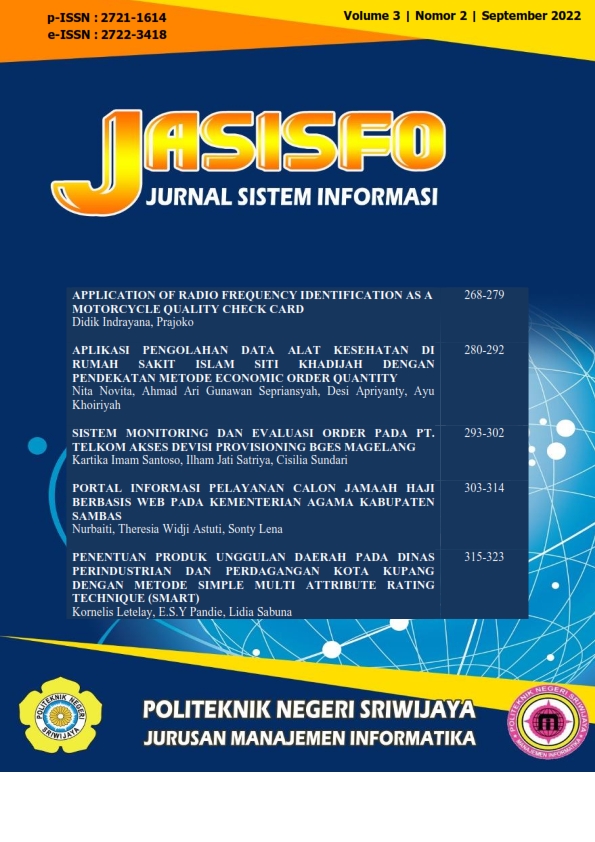Application of Radio Frequency Identification as a Motorcycle Quality Check Card
Keywords:
Radio Frequency Identification (RFID), Pre Delivery Inspection (PDI), RFID ApplicationAbstract
Radio Frequency Identification (RFID) is a wireless communication consisting of 2 (two) tag components and a reader or reader to uniquely identify an object. A reader or reader is a device that has one or more antennas that transmit radio waves and receive signals back from the tag. RFID. In the application of RFID, most use a serial number to store an object’s identity on a microchip and are usually equipped with an antenna, where the antenna and chip are RFID tags. The antenna used and the chip communicate information for identification to the reader or what is known as the reader, then the reader or reader converts the reflected radio waves of the RFID tag into digital information. The application of Radio Frequency Identification (RFID) is intended to assist the process of testing the quality of Honda motorbikes or PDI (pre-delivery inspection) where this is part of the SOP (standard operating procedure) before the motorbike is distributed to consumers to ensure the quality of the motorbike is maintained. The inspections carried out include the outside of the motor and then the inside, below, then testing when the motor is running, the availability of equipment or tools, and equipment documents such as service books and maintenance instructions. Whereas the previous process still uses paper cards which will be discarded when a consumer receives the motor. Applications made using the application of Radio Frequency Identification (RFID) in the form of a card will replace the use of paper when conducting a motor quality inspection.
References
Adam, Wahyu. 2014. “ SISTEM ABSENSI PEGAWAI MENGGUNAKAN TEKNOLOGI RFID â€
Datasheet RFID Reader/Writer Module MIFARE RC522 13.56 MHz http://www.alldatasheet.com/ view.jsp ?Searchword=Mfrc522%20datasheet, diakses 15 Juli 9:46 AM
JOEICT (Jurnal of Education and Information Communication Technology) Volume 3, Nomor Maret 2019: 66 – 75
https://www.corerfid.com/rfid-technology/what-is-rfid/benefits-of-rfid/, diakses 02 Juli
, 21:00 PM
https://www.daya-motora.com/ , diakses 03 Juli 2022, 09.30 AM
https://devcraze.com/tutorials/connecting-rfid-scanner-to-php-using-nodemcu-wifi-module/, diakses 03 Juli 2022, 17.15 PM
Fatah Chetouane,2015 “An Overview on RFID Technology Instruction and Applicationâ€
Learning PHP, MySQL & JavaScript: A Step-by-Step Guide to Creating Dynamic Websites
Charles P M Siahaan, Fakhruddin Rizal B, 2014, “Perancangan Sistem Pembayaran Parkir Secara Otomatis Menggunakan RFID (Radio Frequency Identificationâ€), Jurnal Singunda Ensikom Universitas Sumatera Utara (USU), VOL. 9 NO. 3, Desember 2014
https://www.astra-honda.com/corporate, diakses 10 Juli 2022, 21.30 PM
Kusumawardani, M., Agum Sabda Ilhamy, A., S., & Masudia, P., E., (2016), Hubungan Antara Jenis Tag Nfc (Near Field Communication) dengan Jarak Baca Reader Pada Aplikasi Absensi Mahasiswa, Prosiding SENTIA 2016 – Politeknik Negeri Malang Volume 8 – ISSN: 2085- 2347, (D72-D78), Malang, Jawa Timur.
Amelia Maryam Nurul Syams, Suharini . “Prototipe Sistem Keamanan Menggunakan RFID dan Keypad pada Ruang Penyimpanan di Bank Berbasis Arduino UNOâ€. Jurnal Ilmiah Informatika dan Komputer, Universitas Gunadarma, 2018, Volume 23 No.2, Agustus 2018
Ferdo Eko Christanto, Robby Candra. “ Implementasi Kartu RFID untuk sistem Basis Data Digitalâ€. Jurnal Teknologi Rekayasa, Universitas Gunadarma,Volume 22 No.3, Desember 2017
Charles P M Siahaan, Fakhruddin Rizal B, 2014, “Perancangan Sistem Pembayaran Parkir Secara Otomatis Menggunakan RFID (Radio Frequency Identificationâ€), Jurnal Singunda Ensikom Universitas Sumatera Utara (USU), VOL. 9 NO. 3, Desember 2014
Downloads
Published
Issue
Section
License
Copyright (c) 2022 Didik Indrayana Didik, Prajoko

This work is licensed under a Creative Commons Attribution 4.0 International License.


